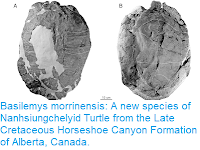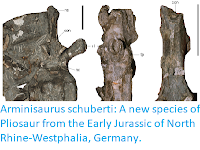The Choristoderes were a group of semi-aquatic Diapsids that appeared in the Middle Jurassic, or possibly earlier, and persisted until the Miocene. Their exact relationships to other Diapsid groups is unclear, with suggestions that they might be Lepidosaurs (members of the group that includes Lizards), Archosauromorphs (members of the group that includes Turtles, Crocodiles, Pterosaurs and Dinosaurs) or a separate group, possibly more closely related to the Archosauromorphs than to the Lepidosaurs. The Choristoderes had three different and distinct body shapes, which may represent taxonomic groups or ecological morphs that repeatedly evolved, these being short-necked, short-snouted forms, long-snouted, short-necked forms, and short-snouted, long-necked forms. The genus Khurendukhosaurus was first described from fragmentary material from the Early Cretaceous of Mongolia, and has subsequently been described from Russia; there are currently two described species, Khurendukhosaurus orlovi and Khurendukhosaurus bajkalensis, though these are both described from fragmemtary material, with no real distinguishing features, so the validity of the second described species (Khurendukhosaurus bajkalensis) is unclear. Due to the limited material available, it has been impossibly to place Khurendukhosaurus in one of the three Choristodere morphogroups, though it has been suggested that it is related to the long-necked Chinese Hyphalosaurus and Japanese Shokawa.
In a paper published in the journal Acta Palaeontologica Polonica on 21 March 2019, Ryoko Matsumoto of the Kanagawa Prefectural Museum of Natural History, Khishigjav Tsogtbaatar of the Institute of Paleontology and Geology of the Mongolian Academy of Sciences, Shinobu Ishigaki of the Okayama University of Science, Chinzorig Tsogtbaatar and Zorig Enkhtaivan, also of the Institute of Paleontology and Geology of the Mongolian Academy of Sciences, and Susan Evans of the Department of Cell and Developmental Biology at University College London, describe a new specimen of Khurendukhosaurus from the Early Cretaceous Khuren-Dukh Formation of eastern Mongolia (the same deposits that produced the first described specimen, and which give their name to the genus ('Khurendukhosaurus' meaning 'Khuren-Dukh Lizard').
The new specimen is a much more complete post-cranianl skeleton, comprising seven cervical vertebrae; eight dorsal vertebrae; six caudal vertebrae; a cervical rib; nineteen dorsal ribs; several gastralia; the right and left humeri and radii; a scapulocoracoid and interclavicle; the right and left ilia, pubes, and ischia; the right and left femora, right tibia, and left fibula.
All elements of the newly discovered specimen of the Choristoderan Khurendukhosaurus sp. from middle–late Albian (Early Cretaceous), Khuren-Dukh, Mongolia. The bones are disarticulated but preserved in close association. This image shows the elements arranged in anatomical position. Matsumoto et al. (2019).
These remains clearly show that Khurendukhosaurus was a long-necked Choristodere, and allowed the performing of a proper phylogenetic analysis, to determine the relationship of this genus to other Choristoderes. This in turn suggests that all long-necked Choristoderes are in fact members of a single clade (i.e. they all share a common ancestor, and that all the common descendants of that ancestor can be placed within the group). Furthermore this group has a rather limited range, with all known species being from the Early Cretaceous of East Asia, with the group apparently not persisting into the Middle Cretaceous or spreading to other parts of the globe.
See also...
Follow Sciency Thoughts on Facebook.







